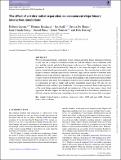Files in this item
The effect of a wider initial separation on common envelope binary interaction simulations
Item metadata
| dc.contributor.author | Iaconi, R. | |
| dc.contributor.author | Reichardt, T. | |
| dc.contributor.author | Staff, J. | |
| dc.contributor.author | De Marco, O. | |
| dc.contributor.author | Passy, J.-C. | |
| dc.contributor.author | Wurster, J. | |
| dc.contributor.author | Herwig, F. | |
| dc.date.accessioned | 2019-10-21T16:30:01Z | |
| dc.date.available | 2019-10-21T16:30:01Z | |
| dc.date.issued | 2017-02 | |
| dc.identifier | 262149647 | |
| dc.identifier | ed18fa76-4349-4917-9251-8f8f12367b1c | |
| dc.identifier | 85003796924 | |
| dc.identifier.citation | Iaconi , R , Reichardt , T , Staff , J , De Marco , O , Passy , J-C , Wurster , J & Herwig , F 2017 , ' The effect of a wider initial separation on common envelope binary interaction simulations ' , Monthly Notices of the Royal Astronomical Society , vol. 464 , no. 4 , pp. 4028-4044 . https://doi.org/10.1093/mnras/stw2377 | en |
| dc.identifier.issn | 0035-8711 | |
| dc.identifier.other | Bibtex: Iaconi+2017 | |
| dc.identifier.other | ORCID: /0000-0003-0688-5332/work/63716938 | |
| dc.identifier.uri | https://hdl.handle.net/10023/18728 | |
| dc.description.abstract | We present hydrodynamic simulations of the common envelope binary interaction between a giant star and a compact companion carried out with the adaptive mesh refinement code enzo and the smooth particle hydrodynamics code phantom. These simulations mimic the parameters of one of the simulations by Passy et al. but assess the impact of a larger, more realistic initial orbital separation on the simulation outcome. We conclude that for both codes the post-common envelope separation is somewhat larger and the amount of unbound mass slightly greater when the initial separation is wide enough that the giant does not yet overflow or just overflows its Roche lobe. phantom has been adapted to the common envelope problem here for the first time and a full comparison with ENZO is presented, including an investigation of convergence as well as energy and angular momentum conservation. We also set our simulations in the context of past simulations. This comparison reveals that it is the expansion of the giant before rapid in-spiral and not spinning up of the star that causes a larger final separation. We also suggest that the large range in unbound mass for different simulations is difficult to explain and may have something to do with simulations that are not fully converged. | |
| dc.format.extent | 17 | |
| dc.format.extent | 2411341 | |
| dc.language.iso | eng | |
| dc.relation.ispartof | Monthly Notices of the Royal Astronomical Society | en |
| dc.subject | Hydrodynamics | en |
| dc.subject | Methods: numerical | en |
| dc.subject | Stars: AGB and post-AGB | en |
| dc.subject | Binaries: close | en |
| dc.subject | Stars: evolution | en |
| dc.subject | QB Astronomy | en |
| dc.subject | QC Physics | en |
| dc.subject | NDAS | en |
| dc.subject.lcc | QB | en |
| dc.subject.lcc | QC | en |
| dc.title | The effect of a wider initial separation on common envelope binary interaction simulations | en |
| dc.type | Journal article | en |
| dc.contributor.institution | University of St Andrews. School of Physics and Astronomy | en |
| dc.identifier.doi | 10.1093/mnras/stw2377 | |
| dc.description.status | Peer reviewed | en |
| dc.identifier.url | https://arxiv.org/abs/1603.01953 | en |
This item appears in the following Collection(s)
Items in the St Andrews Research Repository are protected by copyright, with all rights reserved, unless otherwise indicated.

